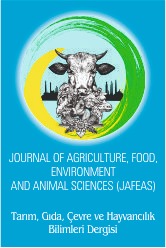
Tarım, Gıda, Çevre ve Hayvancılık Bilimleri Dergisi
Yazarlar: ["Mehwish MUJAHID", "Muhammad Zubair AKRAM", "Samreen NAZEER"]
Konular:-
Anahtar Kelimeler:Mung bean,Drought,Growth parameters,Foliar application,Salicylic acid
Özet: Fabaceae family is of much importance in terms of soil health and fertility concerns. There is a need to evaluate the member of this family under changing climatic conditions. For that purpose, a field experiment was conducted at the experimental farm to evaluate the salicylic acid role in the mung bean (Vigna radiata) under different drought stress conditions. Foliar application of Salicylic acid (SA) was applied after 20, 40, and 60 days after sowing (DAS) intervals by using the knapsack sprayer. For the complete water requirements, a total of four irrigation were applied and for drought conditions skipping the irrigation at 45 to 60 days after sowing. Mung bean treated with the SA improved the morphological characteristics (fresh and dry weight of shoot and whole plant, number of sympodial and monopodial branches, and leaf area index) as compared to the untreated plants that exposed under drought conditions. Foliar application the SA to mung bean also increases the yield related attributes like all these parameters were higher than the untreated plants that grown under drought conditions. Ultimately with enough amount of water and foliar application of salicylic acid to the mung man enhance the biomass and economic yield than the untreated plants under drought conditions. In conclusion, the cultivation of the mung bean under the normal water conditions was more effective and give a high yield with the foliar application of the SA at 200 ppm as compared to the drought conditions.